Integrated Schumann Resonance Intensity as an Indicator of the Global Thunderstorm Activity
Abstract
1. Introduction
2. Formulation of the Problem
3. Model Daily Variations
3.1. Polar Observers
3.2. Diurnal Variations for High-Latitude Observers
4. Model Seasonal Variations
4.1. Polar Observers
4.2. High-Latitude Observers in the Northern and Southern Hemispheres
5. Summary
- The numerical simulations showed a rather high accuracy of the estimates for the diurnal variations in the level of global thunderstorm activity by using the concurrent records of the integrated SR intensity at two high-latitude observatories, UAS and SOUSY. The relative error does not exceed 3% for the daily time resolution of 10 min or more;
- Alterations in the relative intensity of global thunderstorms on the seasonal time-scale are estimated from the SR data with an error of about 10%;
- Since the rate of changes in the level of global thunderstorm activity on the considered time-scales is approximately one octave (the factor of two), the above errors indicate an acceptable overall accuracy of the estimates acquired using simultaneous SR monitoring at the high-latitude observatories in the Arctic and Antarctic.
6. Conclusions
Author Contributions
Funding
Institutional Review Board Statement
Informed Consent Statement
Data Availability Statement
Acknowledgments
Conflicts of Interest
References
- Polk, C. Relation of ELF noise and Schumann resonances to thunderstorm activity. In Planetary Electrodynamics; Coronoti, S.C., Hughes, J., Eds.; Gordon and Breach: New York, NY, USA, 1969; Volume 2, pp. 55–83. [Google Scholar]
- Polk, C. Schumann resonances. In Handbook of Atmospherics; Volland, H., Ed.; CRC Press: Boca Raton, FL, USA, 1982; Volume 1, pp. 111–178. [Google Scholar]
- Bliokh, P.V.; Nickolaenko, A.P.; Filippov, Y.F. Schumann Resonances in the Earth-Ionosphere Cavity; Peter Perigrinus: New York, NY, USA; London, UK; Paris, France, 1980; p. 168. [Google Scholar]
- Sentman, D.D. Schumann Resonances. In Handbook of Atmospheric Electrodynamics; Volland, H., Ed.; CRC Press: Boca Raton, FL, USA; London, UK; Tokyo, Japan, 1995; Volume 1, pp. 267–298. [Google Scholar]
- Nickolaenko, A.P.; Hayakawa, M. Resonances in the Earth-Ionosphere Cavity; Kluwer Academic Publishers: Dordrecht, The Netherlands, 2002; p. 388. [Google Scholar]
- Nickolaenko, A.; Hayakawa, M. Schumann Resonance for Tyros; Springer: Tokyo, Japan; Heidelberg, Germany; New York, NY, USA; Dordrecht, The Netherlands; London, UK, 2014; p. 348. [Google Scholar] [CrossRef]
- Price, C. ELF electromagnetic waves from lightning: The Schumann resonances. Review. Atmosphere 2016, 7, 116. [Google Scholar] [CrossRef]
- Nickolaenko, A.P.; Shvets, A.V.; Hayakawa, M. Propagation at Extremely Low-Frequency Radio Waves. In Wiley Encyclopedia of Electrical and Electronics Engineering; Webster, J., Ed.; John Wiley & Sons, Inc.: Hoboken, NJ, USA, 2016; pp. 1–20. [Google Scholar] [CrossRef]
- Sentman, D.D.; Fraser, B.J. Simultaneous observation of Schumann resonances in California and Australia: Evidence for intensity modulation by local height of D. region. J. Geophys. Res. 1991, 96, 15973–15984. [Google Scholar] [CrossRef]
- Nickolaenko, A.P. Modern aspects of the Schumann resonance studies. J. Atmos. Solar-Terr. Phys. 1997, 59, 805–816. [Google Scholar] [CrossRef]
- Nickolaenko, A.P.; Hayakawa, M.; Sekiguchi, M. Variations in global thunderstorm activity inferred from the OTD records. Geophys. Res. Lett. 2006, 33, L06823. [Google Scholar] [CrossRef]
- Sekiguchi, M.; Hayakawa, M.; Nickolaenko, A.P.; Hobara, Y. Evidence of a link between the intensity of Schumann resonance and global surface temperature. Ann. Geophys. 2006, 24, 1809–1817. [Google Scholar] [CrossRef]
- Bozóki, T.; Sátori, G.; Williams, E.; Guha, A.; Liu, Y.; Steinbach, P.; Leal, A.; Atkinson, M.; Beggan, C.D.; DiGangi, E.; et al. A Schumann Resonance-based quantity for characterizing day-to-day changes in global lightning activity. J. Geophys. Res. Atmos. 2023; in press. [Google Scholar] [CrossRef]
- Kudintseva, I.G.; Nickolaenko, A.P.; Rycroft, M.J.; Odzimek, A. AC and DC global electric circuit properties and the height profile of atmospheric conductivity. Ann. Geophys. 2016, 59, A0545. [Google Scholar] [CrossRef]
- Hynninen, E.M.; Galuk, Y.P. The field of vertical electric dipole source over the spherical Earth with non-uniform along the height ionosphere. In Problems of Radio Wave Diffraction and Propagation; LSU Publ.: St. Petersburg, Russia, 1972; pp. 109–120. [Google Scholar]
- Galuk, Y.P.; Ivanov, V.I. Propagation characteristics of VLF fields in the waveguide Earth–vertically non-uniform anisotropic ionosphere. In Problems of Radio Wave Diffraction and Propagation; LSU Publ.: St. Petersburg, Russia, 1978; pp. 148–153. [Google Scholar]
- Galuk, Y.P. Schumann resonance in the model of global thunderstorm activity uniformly distributed over the Earth. Radio-Phys. Electron. 2015, 6, 3–9. [Google Scholar]
- Lay, E.H.; Rodger, C.J.; Holzworth, R.H.; Dowden, R.L. Introduction to the World Wide Lightning Location Network (WWLLN). Geophys. Res. Abstr. 2005, 7, 02875, 2005 SRef-ID: 1607-7962/gra/EGU05-A-02875. [Google Scholar]
- Rodger, C.J.; Werner, S.; Brundell, J.B.; Lay, E.H.; Thomson, N.R.; Holzworth, R.H.; Dowden, R.L. Detection efficiency of the VLF World-Wide Lightning Location Network (WWLLN): Initial case study. Ann. Geophys. 2006, 24, pp. 3197–3214. Available online: www.ann-geophys.net/24/3197/2006 (accessed on 10 January 2023).
- Hutchins, M.L.; Holzworth, R.H.; Brundell, J.B.; Rodger, C.J. Relative detection efficiency of the World Wide Lightning Location Network. Radio Sci. 2012, 47, RS6005. [Google Scholar] [CrossRef]
- Rodger, C.J.; Brundell1, J.B.; Hutchins, M.; Holzworth, R.H. The world wide lightning location network (WWLLN): Update of status and applications. In Proceedings of the 2014 XXXIth URSI General Assembly and Scientific Symposium (URSI GASS), Beijing, China, 16–23 August 2014. [Google Scholar] [CrossRef]
- Holzworth, R.H.; Brundell, J.B.; McCarthy, M.P.; Jacobson, A.R.; Rodger, C.J.; Anderson, T.S. Lightning in the Arctic. Geophys. Res. Lett. 2021, 48, e2020GL091366. [Google Scholar] [CrossRef]
- Koloskov, A.V.; Bezrodny, V.G.; Budanov, O.V.; Yampolski, Y.M. Polarization monitoring of the Schumann resonances in the Antarctic and recognition of the world thunderstorm activity characteristics. Radiofiz. I Radioastron. 2005, 10, 11–29. [Google Scholar]
- Koloskov, O.V.; Nickolaenko, A.P.; Yampolski, Y.M.; Budanov, O.V. Electromagnetic seasons in Schumann resonance records. J. Geophys. Res. Atmos. 2022, 127, e2022JD036582. [Google Scholar] [CrossRef]
- Christian, H.J.; Blakeslee, R.J.; Boccippio, D.J.; Boeck, W.L.; Buechler, D.E.; Driscoll, E.T.; Goodman, S.J.; Hall, J.M.; Koshak, W.J.; Mach, D.M.; et al. Global frequency and distribution of lightning as observed from space by the Optical Transient Detector. J. Geophys. Res. 2003, 108, 4005. [Google Scholar] [CrossRef]
- Ogawa, T.; Murakami, Y. Schumann resonance frequencies and conductivity profiles in the atmosphere. Contr. Geophys. Inst. Kyoto Univ. 1973, 13, 13–20. [Google Scholar]
- Israel, H. Atmospherische Elekrizitat; Akademische Verlaggeseltschaft: Leipzig, Germany, 1961; Volume 2, 503p. [Google Scholar]

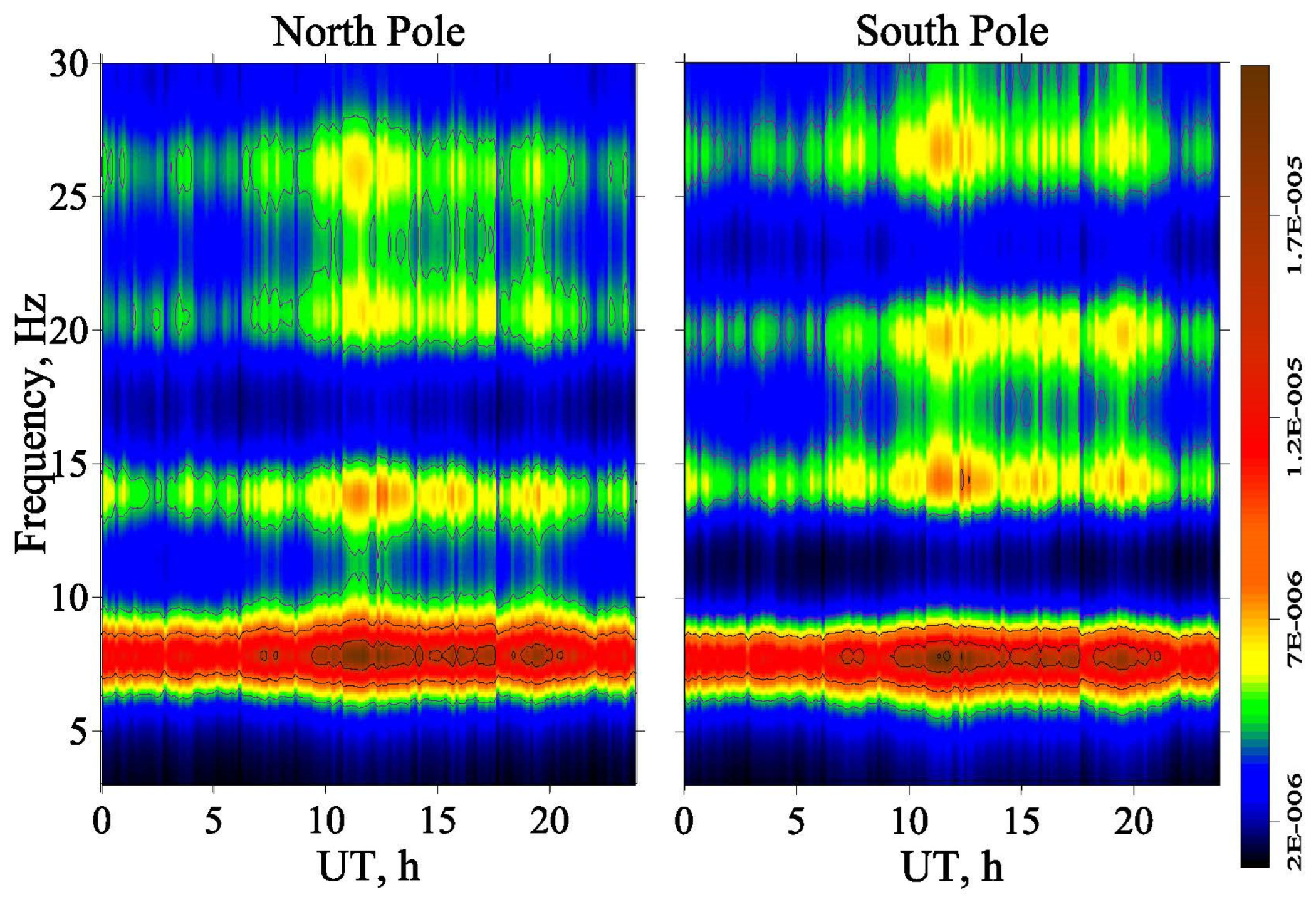



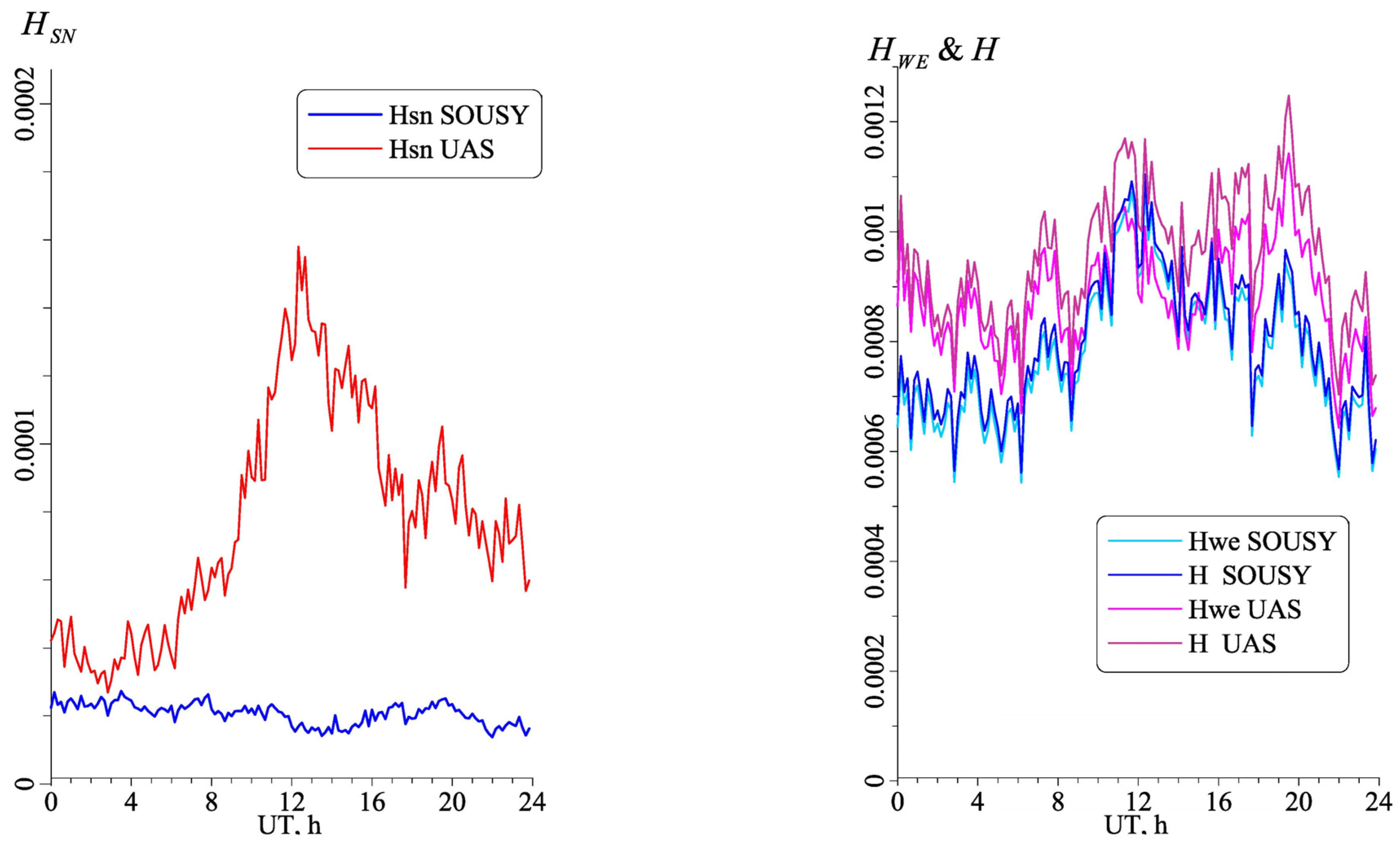

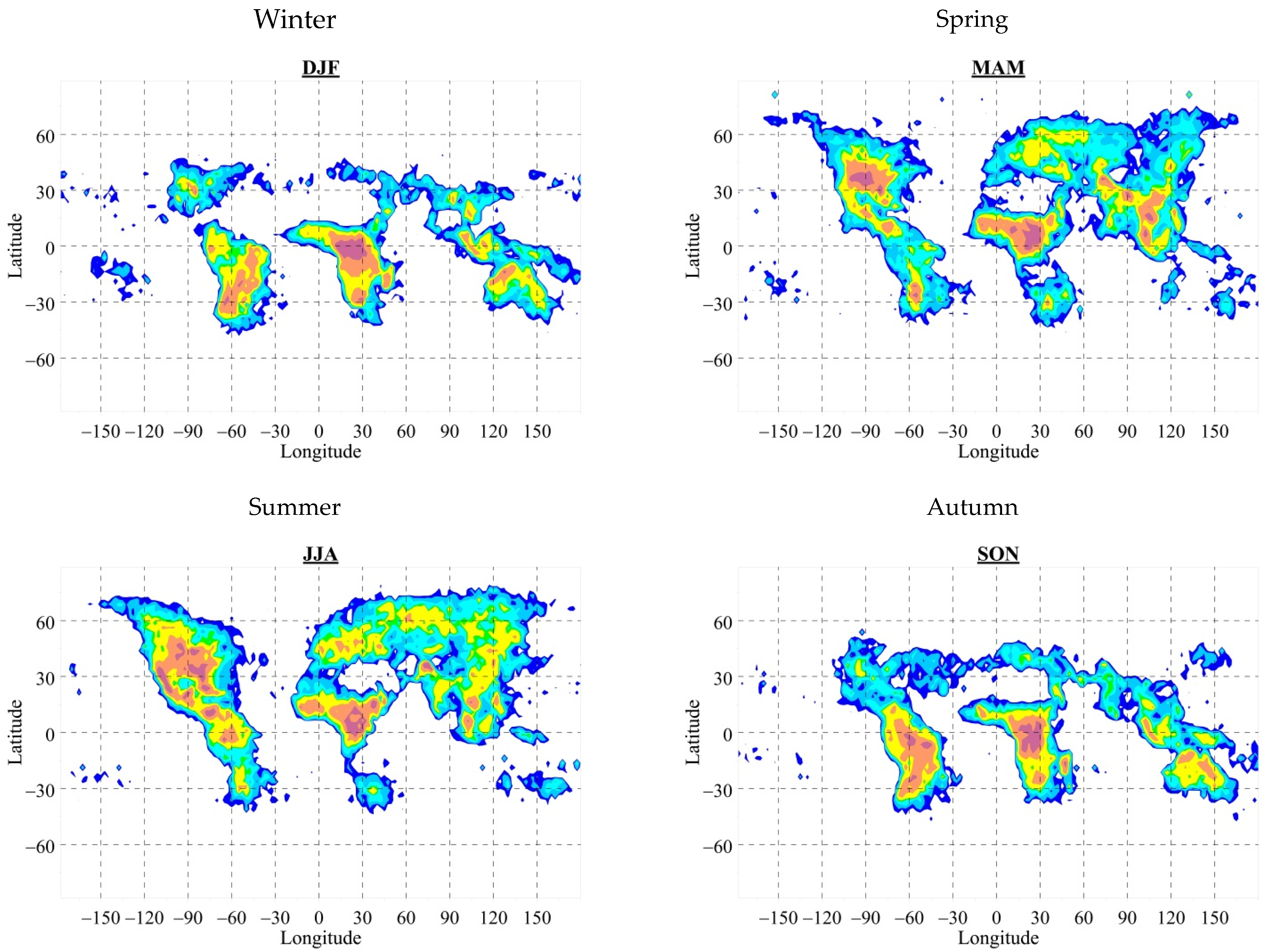
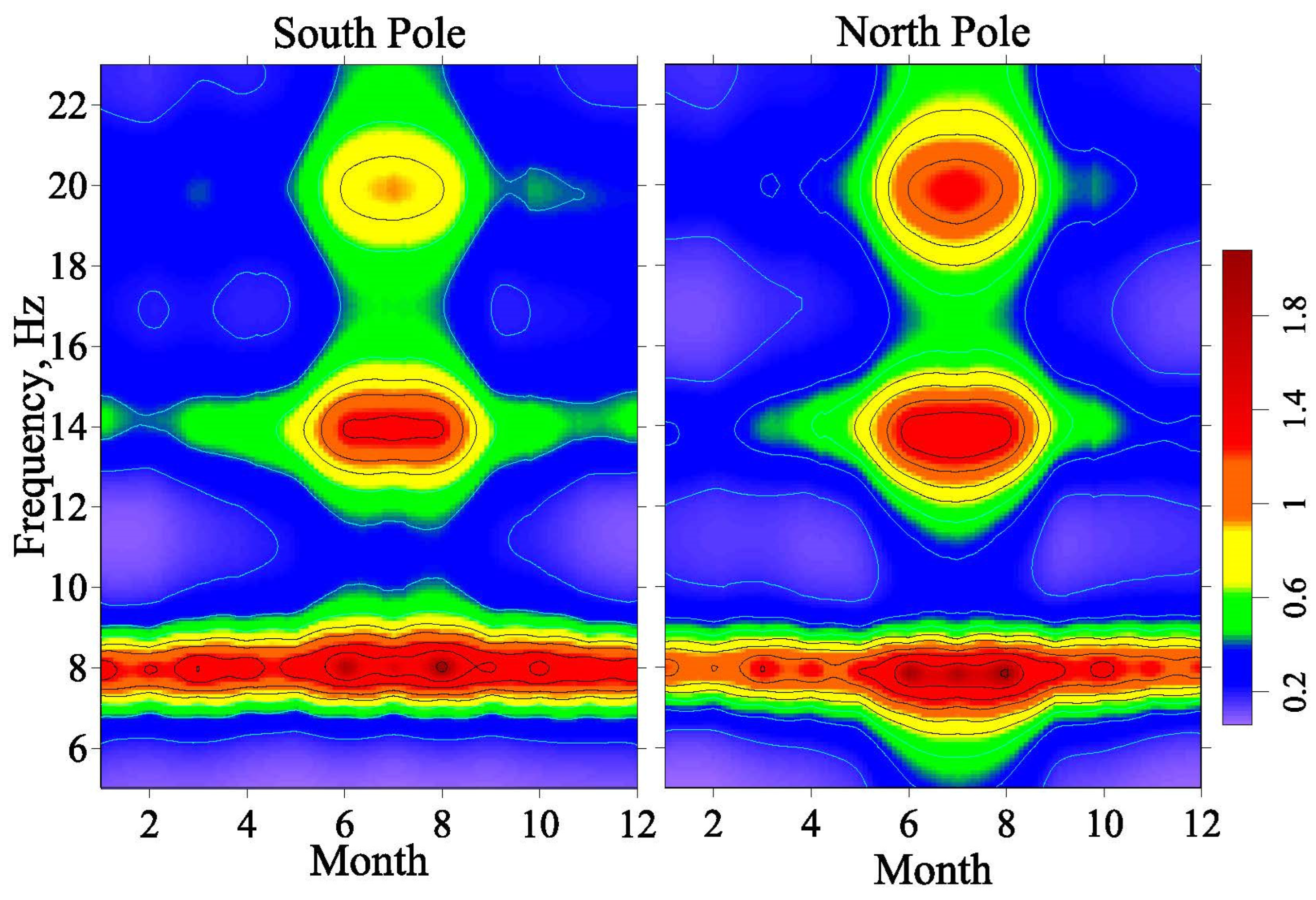

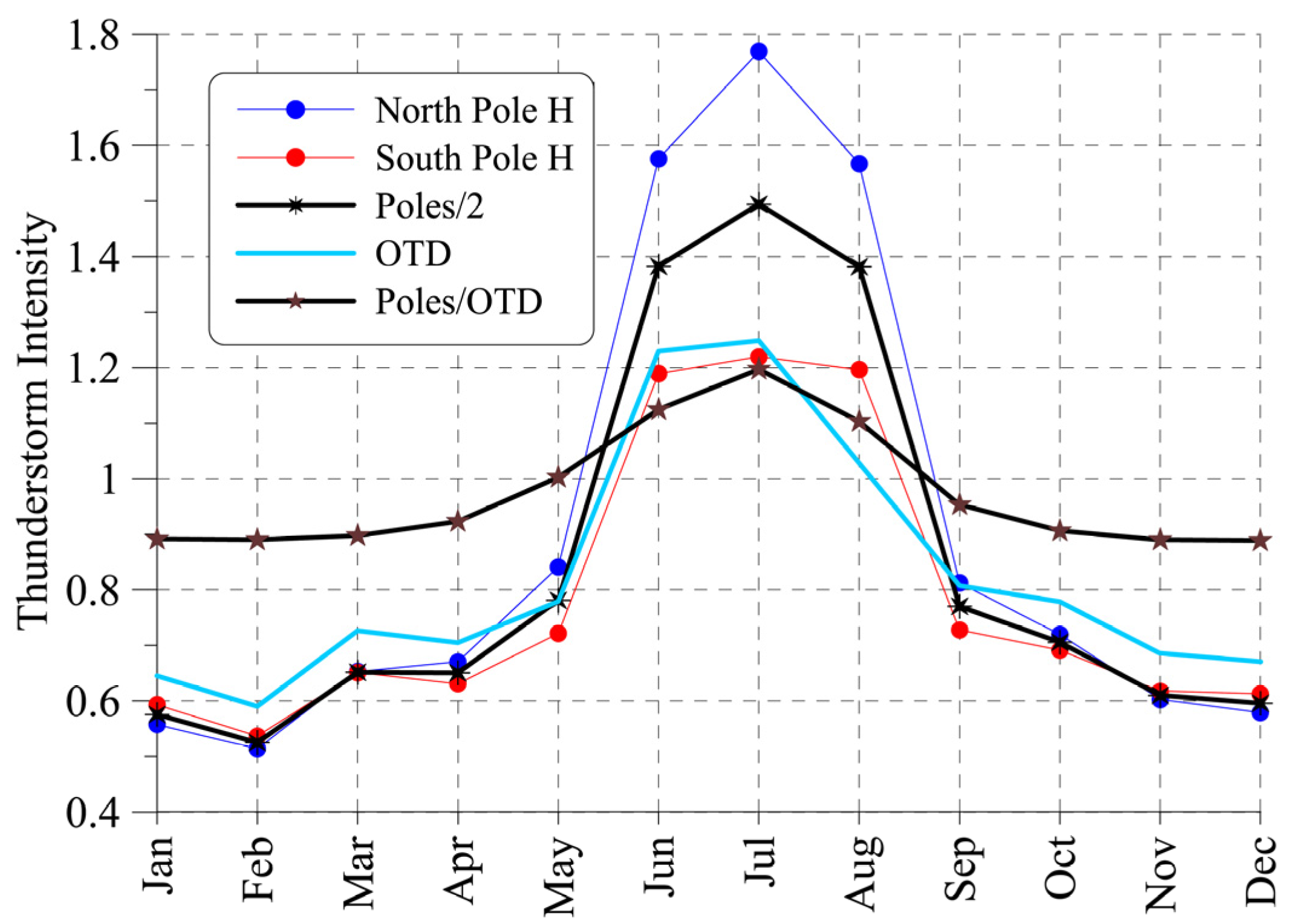
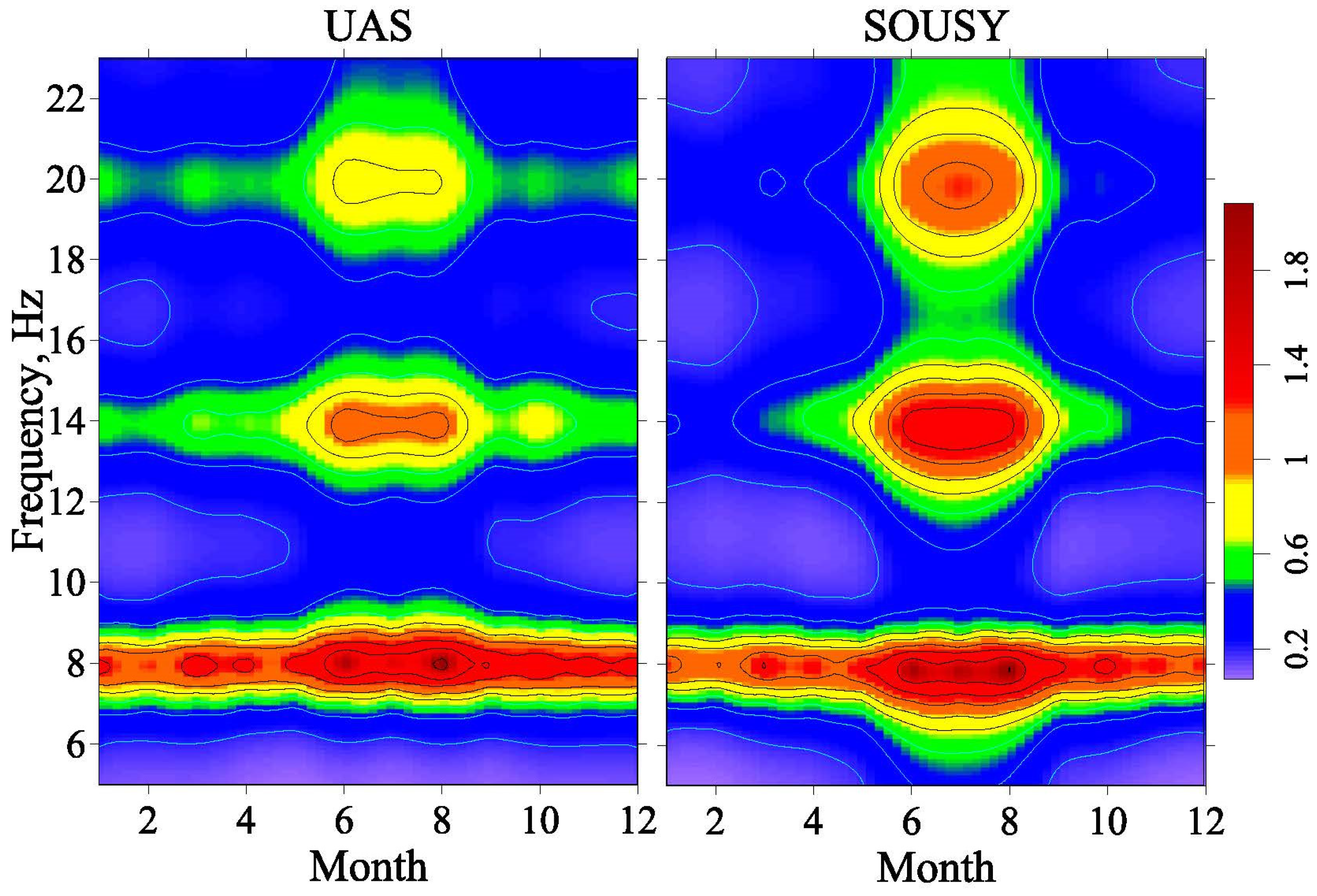
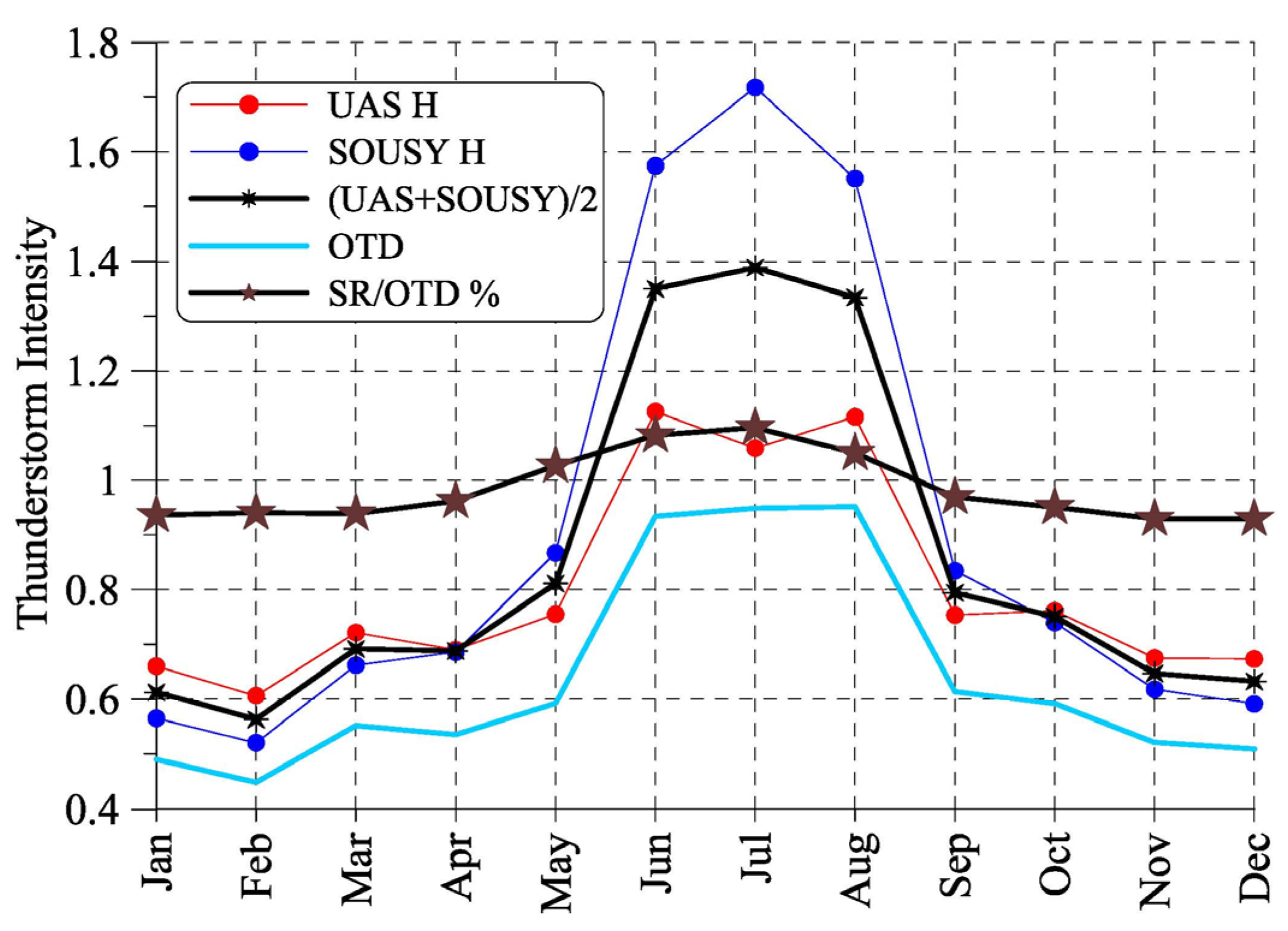
Disclaimer/Publisher’s Note: The statements, opinions and data contained in all publications are solely those of the individual author(s) and contributor(s) and not of MDPI and/or the editor(s). MDPI and/or the editor(s) disclaim responsibility for any injury to people or property resulting from any ideas, methods, instructions or products referred to in the content. |
© 2023 by the authors. Licensee MDPI, Basel, Switzerland. This article is an open access article distributed under the terms and conditions of the Creative Commons Attribution (CC BY) license (https://creativecommons.org/licenses/by/4.0/).
Share and Cite
Hayakawa, M.; Galuk, Y.P.; Nickolaenko, A.P. Integrated Schumann Resonance Intensity as an Indicator of the Global Thunderstorm Activity. Geosciences 2023, 13, 177. https://doi.org/10.3390/geosciences13060177
Hayakawa M, Galuk YP, Nickolaenko AP. Integrated Schumann Resonance Intensity as an Indicator of the Global Thunderstorm Activity. Geosciences. 2023; 13(6):177. https://doi.org/10.3390/geosciences13060177
Chicago/Turabian StyleHayakawa, Masashi, Yuriy P. Galuk, and Alexander P. Nickolaenko. 2023. "Integrated Schumann Resonance Intensity as an Indicator of the Global Thunderstorm Activity" Geosciences 13, no. 6: 177. https://doi.org/10.3390/geosciences13060177
APA StyleHayakawa, M., Galuk, Y. P., & Nickolaenko, A. P. (2023). Integrated Schumann Resonance Intensity as an Indicator of the Global Thunderstorm Activity. Geosciences, 13(6), 177. https://doi.org/10.3390/geosciences13060177






